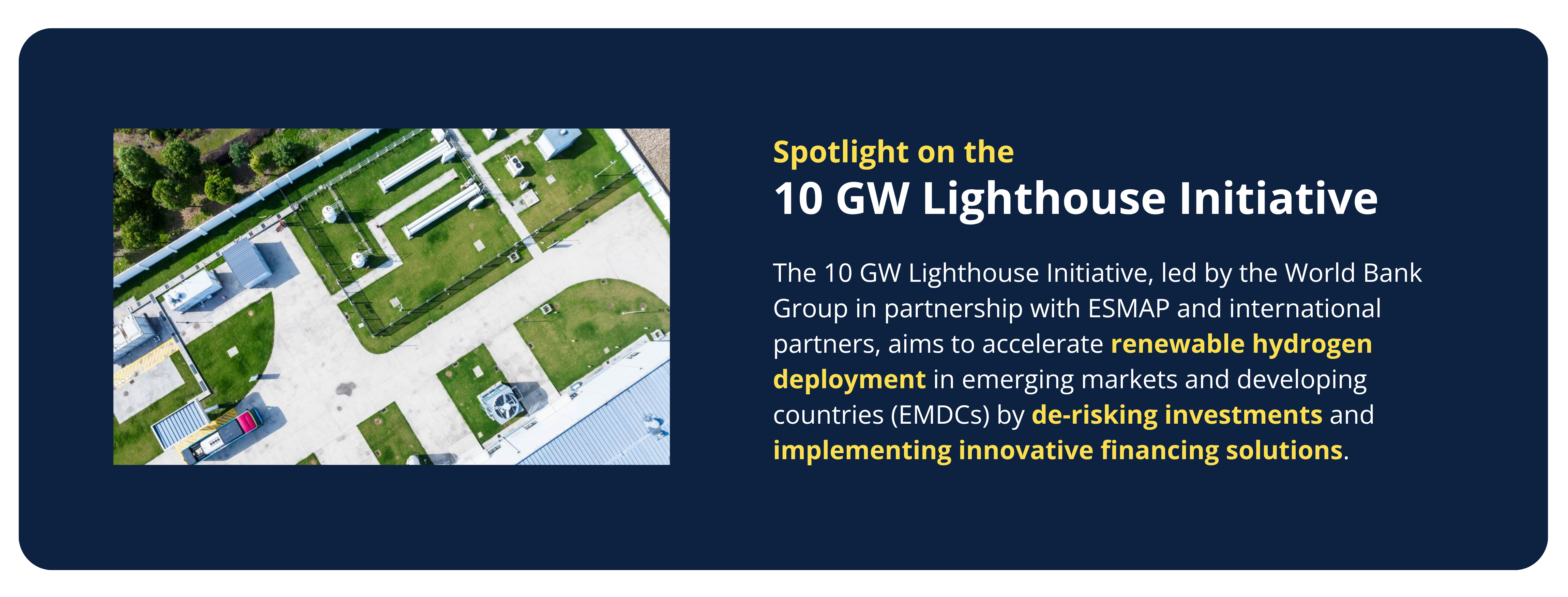
Why renewable hydrogen?
Renewable hydrogen, produced via electrolysis powered by renewable energy, offers a zero-emission alternative for hard-to-abate sectors such as steel, fertilizers, shipping, and aviation. For EMDCs, it represents a unique opportunity to decarbonize economies while attracting foreign investment and creating new engines of growth, employment, and energy security.
For more click here.
What are the barriers to success?
Despite around 500 hydrogen projects announced in EMDCs (excluding China), few have reached the Final Investment Decision (FID) stage due to perceived investment risks, regulatory uncertainties, and a lack of long-term offtake agreements. Supply chain disruptions, insufficient demand-side incentives and sometimes wavering policies all add to the challenges.
What is the purpose of the initiative?
The Lighthouse Initiative aims to bring 10 GW of renewable hydrogen electrolysis capacity to Final Investment Decision by 2030, with individual projects typically ranging from 50 MW to 1 GW.
It seeks to demonstrate the viability of well-designed large-scale clean hydrogen projects in EMDCs, reduce project costs through technology learning and point to innovative solutions for risk mitigation.
The initiative works to combine the financial means and the financial instruments of Development Financing Institutions to enable viable projects.
Who is involved?
The World Bank Group serves as the convener of the 10 GW Lighthouse Initiative, providing organizational support and facilitating coordination across the public and private sectors.
The Initiative unites 15 national and international development finance institutions including: the World Bank Group (IBRD, IFC and MIGA); the African Development Bank; Agence Française de Développement; Asian Infrastructure and Investment Bank; Development Bank of Latin America and the Caribbean (CAF); Cassa Depositi e Prestiti (CDP); European Bank for Reconstruction and Development (EBRD); H2Global; Invest International; Inter-American Development Bank; Invest International; Japan Bank for International Cooperation (JBIC) and KfW.
It is complemented by the fast-growing Hydrogen For Development (H4D) partnership which helps strengthen the market foundations in EMDCs, ensuring the necessary knowledge and frameworks for sustainable growth, energy security, and job creation.
Which developing countries have been prioritized?
Following a rigorous assessment, ten countries (Brazil, Chile, Colombia, Egypt, India, Mauritania, Morocco, Namibia, South Africa, and Tunisia) have been prioritized for fast-tracked support based on their renewable energy potential, policy readiness, and strategic interest.
More than 60 hydrogen projects across these countries have been identified for further analysis to inform technical assistance and future lending operations.
What’s next?
The Lighthouse Initiative is focused on aligning financing institutions, unlocking project pipelines, strengthening due diligence, reducing costs through concessional instruments, and attracting private sector participation. This integrated, country-specific approach ensures that hydrogen strategies reflect local strengths and priorities.
As countries prepare for the next phase of the energy transition, the 10 GW Lighthouse Initiative is working to prove that clean hydrogen can be viable, scalable, and transformative in EMDCs. At COP30, the initiative plans to announce its first project financing results, marking a key milestone in international collaboration for global hydrogen deployment.
For more information on the 10 GW Lighthouse Initiative, please contact dgielen@worldbank.org